When a magician makes a human body disappear, or saws an assistant in half, the trick usually involves a table or box constructed so as to conceal a hidden compartment. Mirrors might suggest a solid form is in fact a void, or strips of darker material might make a relatively wide box form appear thinner than it in fact is, allowing an apparently absent volume to hide something so bulky as a person. The power of such illusions is not simply that one thing looks like another, but these objects appear to contradict how we understand our bodies to ordinarily behave, flaunting the normal rules by which we ourselves interact with tables, chairs and other everyday objects.
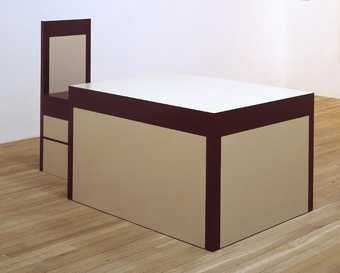
Richard Artschwager
Table and Chair 1963–4
Tate T03793
Photo © Tate
Richard Artschwager’s Table and Chair 1963–4 (fig.1) does not involve any visual trickery quite so devious as this, but its illusions do enact something of the same sense of bodily uncertainty in the face of seemingly familiar objects. The sculpture comprises two rectilinear volumes finished in Formica to suggest the design of a table and chair. As Artschwager has explained of a related work, the result is ‘more like a painting in three-dimensions’ than it is a sculpture: something like ‘mug shots of a table put together to occupy the same space a table would.’1 Muddling the distinctions between images and objects, Table and Chair wilfully confuses the boundaries between the real and the represented.
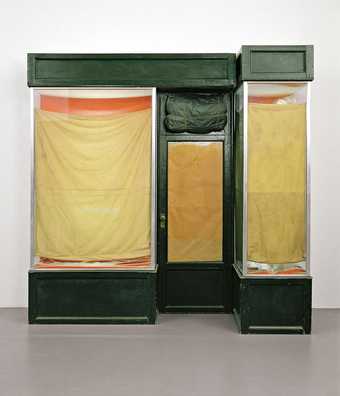
Christo
Store Front 1964
Hirshhorn Museum and Sculpture Garden, Smithsonian Institution, Washington
Table and Chair was among Artschwager’s first works to be exhibited at New York’s Leo Castelli Gallery, where it was shown in a group show alongside Christo’s Store Front 1964 (fig.2) – a work whose own theatrical facade, as shallow as a shop on a Hollywood backlot, must have amplified equivalent qualities in Artschwager’s own contribution to the exhibition. Like Christo’s vulgarised Mondrian façade, Artschwager’s sculpture equally plays at the edges between pop and minimalism in its straddling of realist and abstract sensibilities.
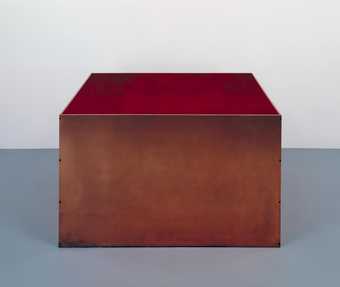
Donald Judd
Untitled 1972
Tate T06524
Photo © Tate
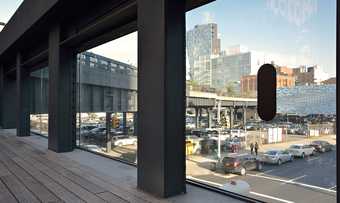
Richard Artschwager
Blp
High Line, New York, exhibited 2012
Photo: Austin Kennedy
In Artschwager’s Table and Chair, the monolithic forms of Donald Judd (such as fig.3) play dress-ups: eschewing the raw industrial materiality of minimalism to foreground the more homely origins of its wood grain cladding, as the artist described it, that ‘material which you lean your elbows on in twenty percent of the luncheonettes in New York.’2 Artschwager’s sculptures are persistent in their orientation towards everyday life. Even his abstract ‘blps’, lozenge-shaped forms that interrupt the spaces in which they are displayed, are not specific objects, concerned only with themselves, but forms that serve to punctuate the surrounding world.3
Artschwager’s evocation of the act of leaning on wood grain laminate points to interest in the bodily register his subject matter provokes. ‘There is something special about furniture’, he observed in a 1965 interview. ‘Pieces of furniture are close to the human scale. This gives furniture a human quality. It relates more intimately to the body in so many ways.’4 Drawing on such properties, and no doubt on the artist’s own work as a cabinetmaker in the 1950s, the subject of Table and Chair draws on everyday experience to invite human interaction – even if the objects cannot be used. Indeed, the artist has repeatedly characterised his artworks as instructional agents. ‘When I instruct through a work to touch, sit on, open, these – both the instruction and the execution – still tend to be acts of the imagination rather than acts of the will,’ Artschwager has explained.5
The speculative act of interacting with Artschwager’s furniture, of inhabiting the space of these objects and gauging what it would be like to use them, is what transforms the act of looking at this sculpture into such an active experience – even if its action always remains in the imagination. When Ivan Karp of the Leo Castelli Gallery gave the title ‘Executive Table and Chair’ to the work now in the Tate collection, it seems less likely that he intended that the prosaic subject matter of the work should evoke corporate status – an ‘attitude’ that the artist understandably regarded as ‘misleading’. But Karp might also have been alluding to the more fundamental meaning of the word, and the demand for viewers to ‘execute’ certain actions that it suggests.6
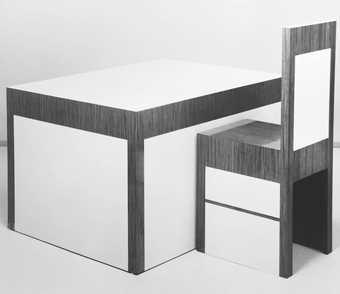
Richard Artschwager
Table and Chair 1963–4
Source: Tate catalogue file, A19289
Photo © Tate
So how might the performance of Table and Chair proceed? One could sit on the chair, but it is uncertain whether one’s feet would fit in the space between the two units.7 Certainly the beige-coloured block ‘under’ the darker surface of the table looks impossible to penetrate – even if the artist recalls that the chair originally ‘wanted to fit under the table’, a remark that tellingly casts the work itself as an active agent in its making.8 It would also be rather difficult to manipulate the chair itself, as its unavoidably solid ‘voids’ make it impossible to grasp the back rail or legs. One might reach to the beneath the rear of its seat – where a real three-dimensional void contradicts all the other represented ones (fig.5). But even if one accepts the beige colour as empty space, continuous with the blonde floor of some equally idealised gallery space, the table’s surface contradicts this logic. As Tate’s black and white acquisition photographs emphasises, the perceptibly solid horizontal table top is rendered in the same pale hue as the other upright ‘voids’ beneath it, confounding the categories of empty and solid, absence and presence.
Again and again, the imaginative process staged by Table and Chair is thwarted by the material facts of the object before us. But such a journey through the formal properties of the work still provides an incomplete account of its performative potential. In a slide lecture on his work delivered in 1973, Artschwager’s own eccentric script for the act of looking at an image of his work provides a messier account of such an encounter:
Please look at this slide. None of your lip. Rather than being rude, let me encourage you to look at this slide. It is easy. Almost everyone else is doing it. You are comfortable seated in a position which makes it very easy to look at this slide. It would be brave, but awkward, not to please in the name of friendship and solidarity. Won’t you look at his slide? Good. Now pretend that that really is a table and chair. Pretend that you are thinking about going over and sitting in that chair, but you wouldn’t want to, just yet, because written in flames above it there is a sign that reads, ‘The Surgeon General has determined that cigarette smoking is dangerous to your health.’ Now pretend to go over and sit in that chair anyway and find it is just a picture of a chair and who are you? But that is O.K. because you are the object of your thoughts.9
With its phatic interruptions, self-reflexive calls for the suspension of disbelief and demands for bodily projection, Artschwager’s one-sided conversation literalises the demands that his artwork makes on its viewers. His unexpected detour into seemingly irrelevant newspaper headlines, followed by philosophical questions about the nature of self and being, vividly capture the contingency and unpredictability of that encounter. Not only does Artschwager’s script wilfully confound the act of looking with other sensory experiences, but he interrupts those insights with the everyday distractions that all viewers bring to their interaction with a work of art.
Artschwager’s vision of art is as a place where the everyday mingles with questions about the nature of being and existence. ‘The art which I make takes place about one step from the normal stir of human activity,’ the artist told art historian Barbara Rose in 1965, reinforcing its temporal and bodily register. ‘By that, I mean that which is purposeful, need-fulfilling, toward an ideal of good (and ever improving) quality.’10 That small step, the space between usefulness and uselessness, reality and representation, produces the sort of momentary bewilderment that demands self-reflection from the viewers of his art. The social potential of such effects remains potent. Here is, for instance, New York-based contemporary artist and writer Gordon Hall reflecting on the contemporary ramifications of an encounter with Artschwager’s sculpture:
If furniture conjures a real body, one that sits in a chair or opens a drawer, what kind of a body do these useless furniture sculptures conjure? …Can I say that these sculptures, through their noninteractive representation of typically interactive situations, produce for me a virtual double of my body? And why does this allow me to conceive of myself, my own gendered experience, in these terms, with this level of ambiguity between the real and the virtual?11
If Artschwager’s 1973 script imagines the act of interacting with his sculpture as producing nothing less than a reflection on the nature of the self, Hall’s reveals its account of what it means to be a person to be just as staged and mutable as Table and Chair itself – hovering between the corporeal properties of the physical world and the layer of representations in which it is coated. Drawing its resonance from everyday experiences but up-ending our expectations of such ordinary encounters, Artschwager opens up a miraculous space in which we are invited to step outside ourselves and reflect on our place in the world.
